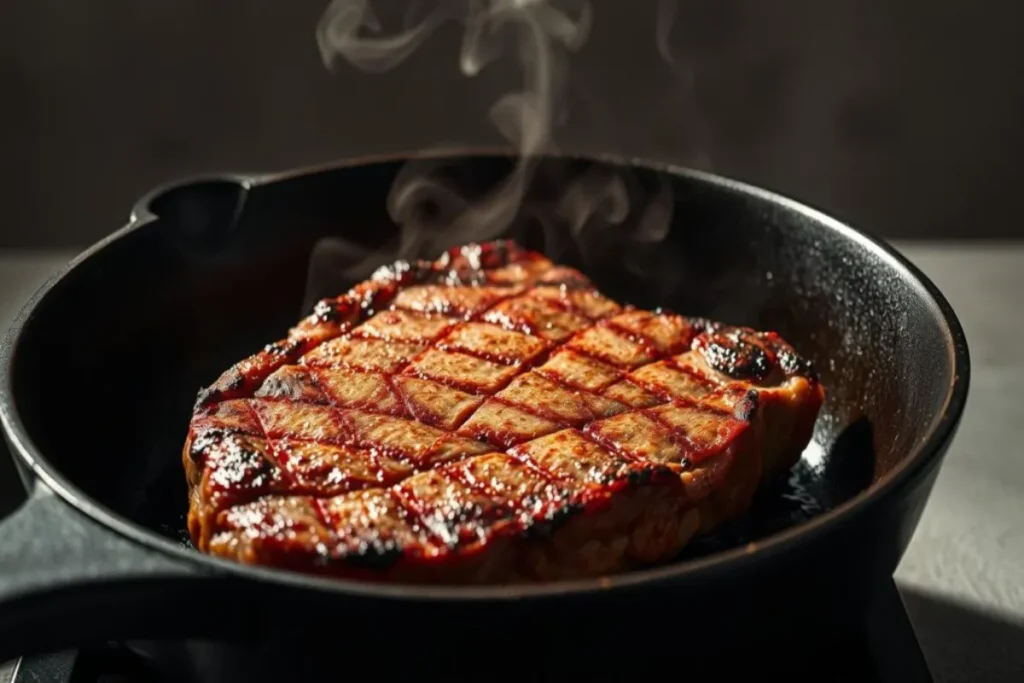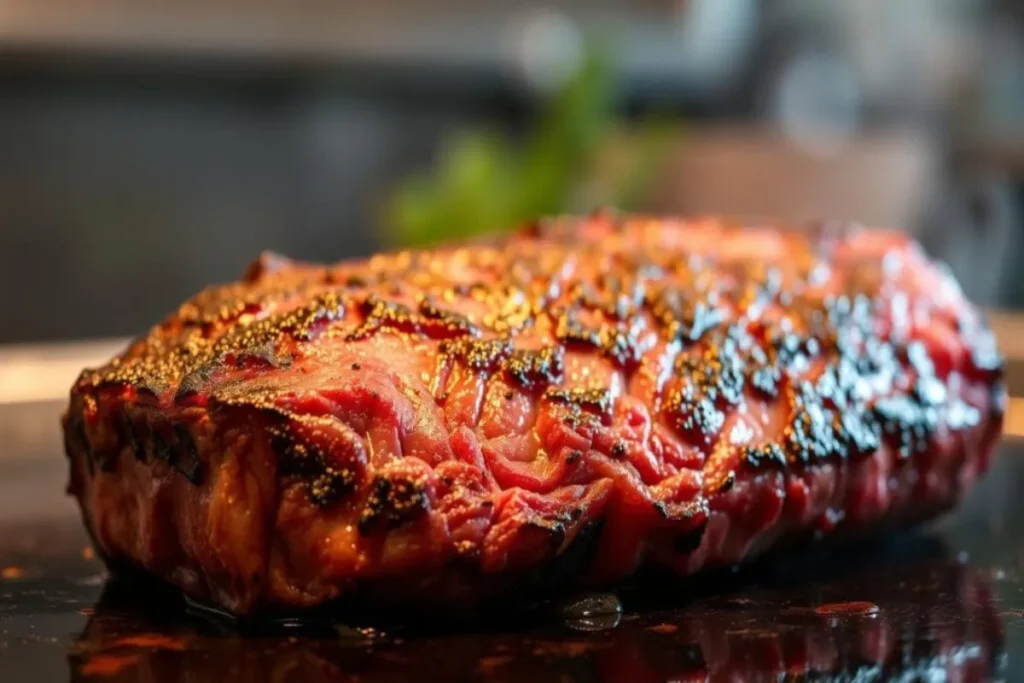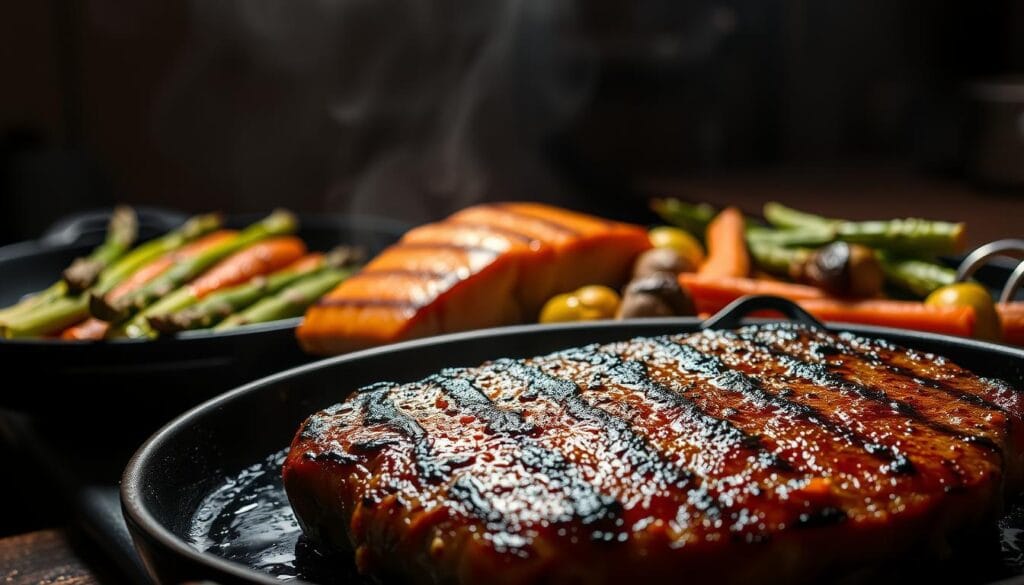Remember that special meal that made your senses come alive? Maybe it was the smell of sizzling meat or the crispy steak that made you drool. Cooking is more than just a task; it’s a way to express yourself and make memories. So, what does “get seared” mean in the world of cooking Get Seared
Learning about searing is key to improving your cooking and impressing your guests. Searing is a Get Seared technique that boosts flavor, texture, and turns simple foods into a feast. By diving into searing, you’ll understand the art and science behind your favorite dishes. This way, you can make unforgettable meals for those you care about.
In this article, we’ll dive into the searing technique, its role in cooking, and how it can make your dishes better. By understanding what “get seared” means, you’ll be ready to create many tasty meals and memorable moments. Get Seared
Table of Contents
Introduction to Searing in Cooking
Searing is a key technique in many cuisines. It involves cooking food at high heat until a brown crust forms. This method not only makes dishes look better but also adds to their flavor.
A *searing overview* shows its long history. Chefs used it to boost flavor and texture. Today, it’s loved for locking in flavors and adding depth to dishes. It makes food preparation more enjoyable.
Cast iron pans are top choices for searing, says many chefs. They stress the importance of salting right, as wrong salting can lose flavor. Gordon Ramsay suggests basting with fat for extra taste. Others add garlic and thyme for extra flavor.
Even though searing doesn’t keep food moist, it’s great for flavor. It’s a favorite among chefs for its role in the Maillard reaction. This technique shows how high heat can change food’s taste and texture, making it a must-know skill.Get Seared
What is Get Seared ? Definition and Overview
Searing is a cooking technique that uses high heat to create a caramelized crust on food. This happens when food is cooked at temperatures between 140 to 165 °C (280 to 330 °F). Mastering searing unlocks complex flavors and aromas through the Maillard reaction.
This reaction is key to browning and flavor in seared foods. To understand searing, you need to grasp the Maillard reaction. It creates hundreds of unique flavor compounds, influenced by the food’s makeup, Get Seared time, and air presence.
Some compounds have very low odor thresholds, making the aroma intense. While searing boosts flavors, it’s important to know that high heat can create acrylamide, a possible carcinogen.Get Seared
Chefs use searing to make a delicious crust that keeps juices in and improves texture. This method not only enhances flavors but also makes dishes more appealing. Knowing the science behind searing can help you cook like a pro at home.
What Does Get Seared Mean?

The phrase “get seared” is very important in cooking. It means to cook food, like meats, very hot. This makes the food taste better and keeps it juicy.
Knowing about searing is key for anyone who cooks. It’s important for beginners and experts alike.
Concept of Searing in Culinary Terms Get Seared
Culinary searing cooks food fast at high heat. It makes the outside brown and the inside tender. Learning about searing can make you a better cook.
In different languages, searing has strong meanings. In Chinese, it means extreme feelings. In Spanish, it means sharp or intense, showing the sizzling effect in cooking.
Importance of Searing in Meal Preparation
Searing is very important for meals that need deep flavors. Many chefs use it. Heat and meat interact, creating complex tastes through caramelization and Maillard reactions.
This process makes food look good and taste even better. A seared steak, for example, is tender and makes meals more enjoyable.
The Searing Technique Explained
The searing technique is key for a flavorful crust on meats. Start by picking the right cooking gear. A cast iron pan is best because it holds heat well, giving you a deep sear.
Think about your meat’s thickness before cooking. Boneless steak should be 1-1.5 inches thick for the best results. Salt the steak right before cooking or at least 40 minutes ahead. This helps the meat taste better by drawing out moisture and then reabsorbing it.
Heat your pan on the stove for 5-6 minutes until it’s at least 375°F (191°C). Use a digital thermometer to check the meat’s internal temperature. A one-inch steak cooks in 3-4 minutes per side for medium-rare.
Flipping the steak every 30-60 seconds helps cook it evenly. Also, choose the right oil. Avocado oil is great because it has a high smoke point of 520°F, preventing smoke and keeping the heat stable.
For thicker steaks, try reverse searing. Start in a low oven and finish on the stove for a perfect crust. Always let the steak rest for 5-10 minutes after cooking. This lets the juices spread for a juicier bite.
Types of Foods That Can Be Seared
Searing is a versatile technique that can enhance a variety of foods. It’s not just for meats; seafood also benefits greatly. The process caramelizes the surface, creating a delicious crust. It also locks in moisture and flavor.
Understanding which foods can be seared opens up a world of culinary possibilities.
Seared Meat: The Art of Cooking Steaks
Perfectly cooked steaks are unmatched when it comes to seared meat. Cuts like ribeyes, porterhouses, and strip steaks offer rich flavors and textures. When seared right, they shine.
Traditional searing can create a thin gray ring around the edges. This might mean the heat has gone too deep. Cold searing is a better approach. It lets you flip the steak multiple times, creating a crust without overcooking the inside.
Salting the steak ahead of time helps draw out moisture. This makes the steak juicy and well-cooked.
Seared Seafood: Enhancing Flavor and Texture
Seared seafood, like scallops and shrimp, also benefits from this method. The high heat creates a caramelized crust while keeping the seafood tender. This technique is great for quick cooking, adding flavor to the exterior.
Getting the right temperature is essential. Cooking at 300 degrees Fahrenheit or more ensures a golden color. Cold searing is also effective, helping to achieve a golden crust without overcooking.
How to Achieve the Perfect Sear

Getting the perfect sear is key to better flavor and texture in cooking. Knowing the right tools and steps can make a big difference. Start by picking the right equipment and learning a few essential techniques.
Choosing the Right Equipment for Searing
The right gear is the first step to a great sear. A cast iron skillet or outdoor grill works best for high heat. Make sure your equipment can handle high temperatures without damage.
Use a reliable infrared thermometer to check the surface temperature. Preheat your pan or grill to at least 450°F before cooking. This ensures your steak, at least 1.5 inches thick, gets a golden crust.
Steps for Searing Food Effectively
Here are the steps for a perfect sear:
- Preheat your skillet or grill for several minutes.
- Add about 2 tablespoons of neutral oil to the hot surface.
- Carefully place your seasoned steak on the cooking surface. Cook one side for 3-4 minutes until a beautiful crust forms.
- Flip the steak using tongs and cook for another 2-3 minutes, achieving a golden crust on both sides.
- For a richer flavor, add 2 tablespoons of unsalted butter, minced shallots, crushed garlic, and fresh herbs during the last minute of cooking. Baste the steak for enhanced buttery finish.
- Use an instant-read thermometer to check doneness; for medium-rare, the target is 130°F.
- After cooking, allow the steak to rest for 5-10 minutes to let the juices redistribute.
By following these steps and using the right equipment, you’ll achieve a perfect sear. This will take your dishes to the next level.
Benefits of Searing Your Food
Searing your food brings many advantages that make meals better. The main benefit is the Maillard reaction. This happens when food is heated high and changes flavor and taste.
Another great thing about seared food is how it looks. The golden-brown crust adds beauty and flavor. It makes dishes more appealing and satisfying.
Searing also helps keep nutrients in your food. Cooking at high heat for a short time locks in vitamins and minerals. This is healthier than long cooking times.
Searing is useful for making meals better. It makes braising and stews taste richer. The browned bits in the pan can be used to make tasty sauces.
It also makes food safer. Searing kills bacteria on the surface, which is important for cooking meats. This way, you can enjoy food that’s safe and flavorful.
Learning to sear can make your cooking better. It adds new textures and flavors to your dishes. It makes every meal more enjoyable.
Common Searing Methods and Techniques
Searing is a key cooking technique that adds a rich, flavorful crust to dishes. There are many searing methods, each with its own benefits and best uses. Knowing these methods helps you pick the right one for your cooking.
The stovetop method is a favorite for searing. It uses a heavy-bottomed pan, like cast iron or stainless steel, heated to 375°F to 400°F. This is great for meats like steak and chicken, as it brings out deep flavors.
Oven-broiling is another good searing technique. It places food near high heat, like in an oven, for a seared exterior. This method works well for denser meats or larger portions, keeping them moist and evenly cooked.
Grilling is a top choice for searing outdoors. The grill’s direct heat gives meats a nice char and smoky taste. It’s perfect for steaks, fish, and veggies, needing high heat for a golden-brown crust.
| Searing Method | Ideal Foods | Temperature Range | Cooking Time |
|---|---|---|---|
| Stovetop | Steak, Chicken Breast | 375°F – 400°F | 2-4 minutes per side |
| Oven-Broiling | Denser Cuts of Meat | High Heat (Broil) | Varies by thickness |
| Grilling | Steaks, Fish, Vegetables | High Heat | 2-5 minutes per side |
Each searing technique has its own purpose and works best with certain foods. Choosing the right method can greatly improve your meal’s quality. Proper searing not only keeps food moist but also boosts flavors, making it a key cooking skill.
Seared Recipes to Try at Home

Want to improve your cooking skills? Try seared recipes to take your dishes to the next level. We’ll dive into two favorites: the classic seared steak and seared scallops. Both are tasty and easy to make.
Classic Seared Steak Recipe
To make a perfect seared steak, you’ll need a few ingredients and follow some steps:
- 2 USDA Prime ribeye steaks (1 to 1.5 inches thick)
- Salt and pepper to taste
- 2 tablespoons of avocado oil or vegetable oil
- Optional: Fresh herbs (such as rosemary or thyme) for flavor
Steps:
- Let the steaks warm up at room temperature for about 30 minutes.
- Season each steak with salt and pepper.
- Heat a cast iron skillet over medium-high, adding oil when hot.
- Put the steaks in the skillet and sear for 4-5 minutes until they’re golden.
- Flip the steaks and sear the other side for 5-10 minutes, depending on how done you like them.
- Check the steaks with a meat thermometer: Rare (125°F-130°F), Medium-Rare (135°F-140°F), Medium (145°F-150°F).
- After cooking, remove the skillet from heat and let the steaks rest for 5-10 minutes. This helps keep their juices in before slicing.
Seared Scallops: A Gourmet Touch
Seared scallops add a fancy touch to your meals. Here’s how to make them simply and elegantly:
- 12 large sea scallops
- Salt and black pepper to taste
- 2 tablespoons of oil (avocado or vegetable oil)
- 1 tablespoon of unsalted butter
Steps:
- Pat the scallops dry with paper towels for a better sear.
- Season both sides with salt and pepper.
- Heat oil in a skillet over medium-high until it starts shimmering.
- Add scallops to the skillet without crowding and sear for 2-3 minutes until golden.
- Flip the scallops and add butter, cooking for another 2-3 minutes until they’re opaque and tender.
- Serve them right away, maybe over creamy risotto or with roasted veggies for a full meal.
These seared recipes, like the classic seared steak and seared scallops, are a great way to enjoy gourmet flavors at home. They also show off your cooking skills.
How Searing Affects Flavor and Texture
Searing changes how food tastes and feels. It creates a crust that keeps juices in, making flavors richer. This makes food taste better and feel different, improving your meal.
When you sear meat, like steak, it gets a brown crust. This crust helps keep moisture in. If you don’t sear, the meat tastes less good and feels different.
Reverse searing is different. It cooks meat slowly first, then sears it quickly. This keeps the meat tender and lets its natural flavors come out. Even with a thin crust, the flavors are deep.
Knowing how to sear is key to better cooking. Traditional searing gives a crispy outside and strong flavors. Reverse searing makes meat tender and juicy. Choosing the right method can make your food taste and feel amazing.
Common Mistakes When Searing Food
Searing can make your food taste better and feel more tender. But, making common mistakes can ruin your dish. To get it right, focus on a few key things during searing. Here are some mistakes to watch out for:
- Overcrowding the Pan: Too much food in the pan traps steam. This stops a good crust from forming. Make sure to leave space between each piece for heat to move around.
- Improper Temperature Control: If your grill or pan isn’t hot enough, cooking won’t be even. You need a steady, high heat for a great sear.
- Moisture on the Surface: Moisture stops the Maillard reaction, which is key for a golden crust. Dry the meat’s surface before cooking.
- Inadequate Seasoning: Salting the meat 30 minutes before cooking helps with flavor and moisture. Skipping this can make your food taste bland.
- Wrong Cooking Oil: Using oils with low smoke points, like extra virgin olive oil, can burn and taste bad. Use oils with high smoke points, like canola or avocado oil, for better taste.
The table below shows the best cuts and techniques for searing:
| Cut Type | Recommended Usage | Notes |
|---|---|---|
| Ribeye | Grilling | Higher fat content offers better flavor and crust. |
| Flank | Pan Searing | Thin cuts provide increased surface area for good sear. |
| Chuck | Braising | Best suited for slow cooking to break down tough fibers. |
| Ahi Tuna | Grilling | Requires thickness of 1 to 1½ inches for ideal sear. |
By avoiding these common mistakes, you can improve your searing skills. Understanding the importance of temperature, space, and technique will help you master searing.
Conclusion
Understanding sear is key in cooking. It makes dishes look better and taste richer. By learning to sear, you can turn simple foods into something special.
This summary shows how important the right tools and techniques are. Using cast iron skillets or grills at 500°F to 600°F is essential. Also, letting the meat rest helps juices spread evenly, making it taste better.
Adding searing to your cooking skills will make your kitchen journey more rewarding. With time, you’ll see how searing improves your dishes and your cooking abilities. This will help you create meals that everyone will love.
For more delicious recipes and kitchen inspiration, stick around and explore our other articles.

